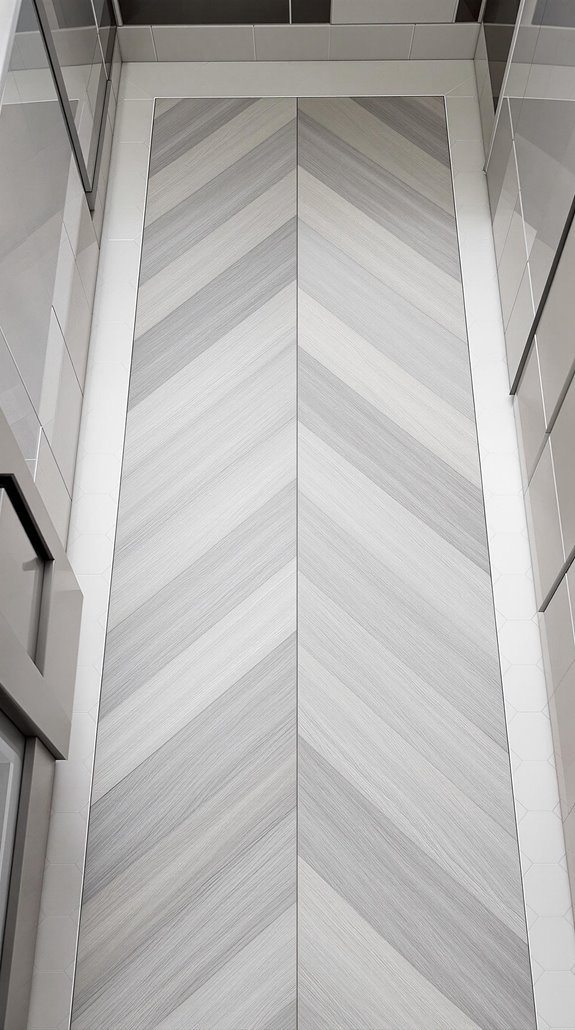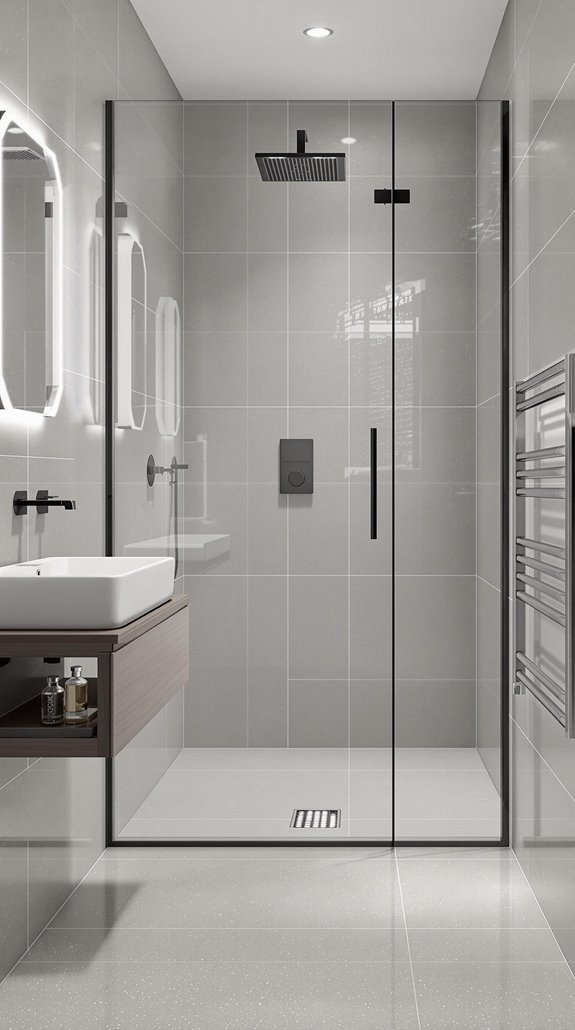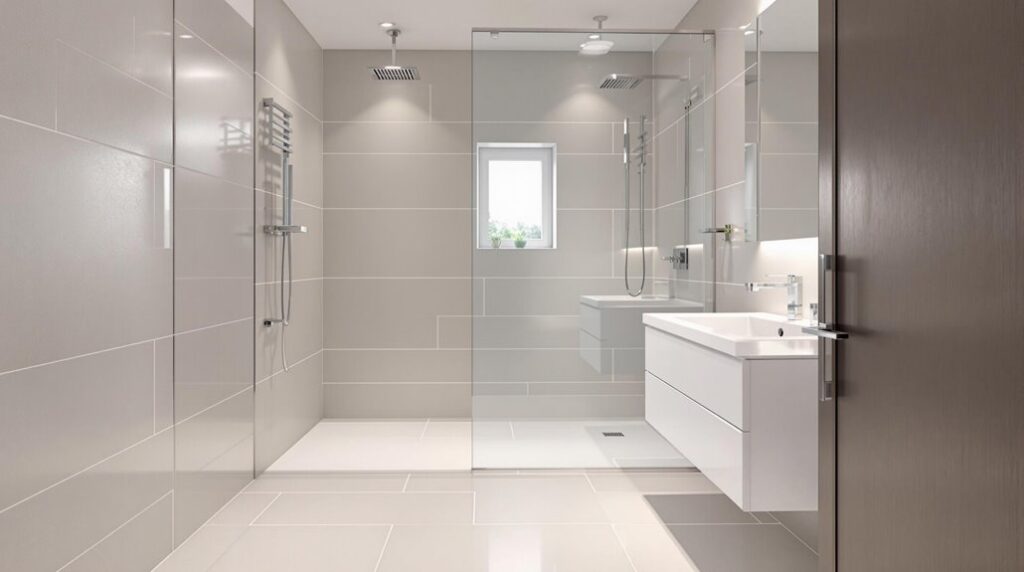I’ve worked with countless small UK bathrooms, and I can tell you that choosing the right flooring makes or breaks your space. You’re dealing with moisture, limited square footage, and the need for both style and practicality. The wrong choice will make your bathroom feel cramped and dated, while the right materials can transform even the tiniest space into something impressive. Let me show you exactly which options deliver maximum impact for your specific situation.
Key Takeaways
- Choose large-format tiles with minimal grout lines to create visual continuity and make small bathrooms appear more spacious.
- Select light-coloured flooring in whites, beiges, or pale greys to reflect light and enhance the illusion of space.
- Install waterproof vinyl flooring with groutless installation to eliminate visual fragmentation and create seamless, larger-feeling areas.
- Lay tiles vertically to create height perception in compact bathrooms with limited headroom space.
- Consider textured surfaces with R10/R11 slip-resistance ratings for safety while maintaining stylish aesthetics in confined areas.
Ceramic and Porcelain Tiles for Compact Bathrooms

When renovating a small bathroom, ceramic and porcelain tiles offer exceptional flooring solutions that combine durability with practical benefits. I’ll explain why these materials work brilliantly in compact spaces.
Porcelain tiles are nearly impervious with water absorption below 0.5%, making them ideal for moisture-heavy environments. They’re scratch and stain-resistant, requiring minimal maintenance – just simple mopping with soap and water. This durability guarantees your investment lasts years without replacement concerns, ensuring you enjoy a long-lasting flooring solution that withstands the test of time.
Ceramic tiles offer a lighter, more affordable alternative with 0.5-3% water absorption. While less dense than porcelain, they’re easier to install and replace if needed. Their smooth surface naturally resists stains, making cleaning particularly straightforward for busy households.
Both materials provide extensive design versatility. Large-format tiles create seamless looks that make small bathrooms appear larger, while lighter colours enhance spatial perception. You’ll find countless patterns and textures to match your style preferences.
Vinyl Flooring Solutions That Maximise Space
While ceramic and porcelain tiles excel in durability, vinyl flooring offers compelling advantages for small bathrooms where space optimization is paramount. I’ll explain why vinyl deserves serious consideration for your compact space.
Vinyl’s groutless installation eliminates visual fragmentation that makes small bathrooms feel cramped. Large-format planks create continuous patterns that unify areas visually, while wood-look designs add optical depth illusions. Light-reflective surfaces amplify both natural and artificial light, making spaces appear larger. Additionally, choosing the right flooring materials can significantly influence your renovation costs.
You’ll appreciate vinyl’s practical benefits too. It’s inherently waterproof, preventing subfloor seepage and mold growth. The softer surface feels warmer underfoot than tiles while providing excellent slip resistance when wet. Installation costs 30-50% less than porcelain, and you can often install it over existing floors without extensive preparation. The non-porous surface also inhibits mold and mildew growth, promoting a healthier bathroom environment in your compact space.
Laminate Options for Budget-Conscious Homeowners
Although laminate flooring often gets overlooked in bathroom renovations, it presents an excellent middle ground between vinyl’s affordability and tile’s durability for budget-conscious homeowners. I’ve found waterproof laminate particularly compelling for small bathrooms, offering genuine water resistance through two manufacturing methods: surface coating with water-repellent chemicals or soaking the HDF board core. Regular inspections for structural integrity can help identify any potential issues early on.
You’ll appreciate the financial benefits – laminate costs around £60 per square metre including installation, making it notably cheaper than hardwood alternatives. The scratch-resistant surface comes with 20-25 year guarantees, providing long-term value. When selecting your laminate, remember that thicker boards with durable wear layers and finishes are generally more expensive but offer enhanced durability for high-moisture environments.
For your small bathroom project, waterproof laminate delivers both practicality and style. It’s specifically designed for moisture-prone areas like bathrooms and kitchens, giving you confidence in your investment while maintaining that authentic wood appearance you’re after.
Natural Stone Flooring in Small UK Bathrooms
Natural stone transforms small UK bathrooms into sophisticated spaces that rival high-end hotel designs, though it demands careful consideration of both practical and financial factors. Incorporating sustainable materials aligns with contemporary design trends while enhancing your space. I recommend limestone or slate for their durability and water resistance. Light-coloured stones like beige limestone create spaciousness illusions – vital in compact areas. You’ll pay £36.90-£55.90 per square metre, plus 20-30% installation costs, but you’re investing in longevity that outlasts vinyl alternatives.
Essential maintenance includes initial sealing with impregnator, then re-sealing every 6-12 months. Use only pH-neutral cleaners to prevent etching damage. For best results, choose small 300x300mm tiles or large formats to minimise grout lines. Tumbled finishes like Avalon Limestone offer cost-effective texture while enhancing slip resistance in wet conditions. Marble tiles create a fresh, hygienic atmosphere that elevates the perceived value of even the smallest bathroom spaces.
Cork Flooring for Eco-Friendly Bathroom Design
Since environmental consciousness drives modern bathroom design choices, cork flooring emerges as the premier eco-friendly option that doesn’t compromise on performance or aesthetics. I’ll explain why cork’s becoming the go-to choice for sustainable bathroom renovations.
Cork’s harvested from oak trees without causing damage, promoting forest regeneration and carbon sequestration. The production process uses renewable energy, creating a considerably lower carbon footprint than vinyl or ceramic alternatives. When it’s time to replace your flooring, cork biodegrades naturally, eliminating landfill concerns. Additionally, proper insulation can enhance the energy efficiency of your home, leading to significant cost savings on heating bills.
Beyond sustainability, cork’s naturally water-resistant due to suberin, a waxy substance that repels moisture. I recommend glue-down installation with sealed edges for best bathroom performance. You’ll appreciate cork’s hypoallergenic properties and natural resistance to bacteria and mold, creating healthier indoor air quality for your family. Cork’s natural warmth makes it ideal for barefoot walking, providing comfort that cold ceramic tiles simply can’t match.
Space-Enhancing Design Tricks and Layout Tips
When you’re working with a cramped bathroom, strategic design choices can transform your space from claustrophobic to surprisingly spacious. I’ll share the techniques that actually work.
Light, neutral colors on walls and floors create an illusion of expanded space. Maximize natural light through windows while installing LED mirrors to amplify brightness. Position large mirrors opposite windows to double illumination and perceived dimensions.
Wall-mounted fixtures free up essential floor space. Choose floating vanities, wall-hung toilets, and corner showers to improve flow. Replace swinging doors with sliding glass panels to eliminate obstructions, ensuring you have an unobstructed permitted development area for movement.
Use large-format tiles with minimal grout lines for visual continuity. Clear glass shower screens unify the room without barriers. Install tall, narrow storage and recessed niches to maximize vertical space without consuming your precious floor area. Consider laying tiles vertically to create a sense of height in spaces with limited headroom.
Waterproof Flooring Materials for Wet Room Areas

While layout optimization maximizes your bathroom’s spatial potential, selecting the right waterproof flooring becomes critical for wet room functionality and longevity. I’ll guide you through proven waterproof materials that perform reliably in moisture-heavy environments.
Luxury vinyl flooring offers excellent value with its waterproof core construction and seamless installation that eliminates moisture-trapping gaps. You’ll find slip-resistant surfaces enhance safety while versatile designs mimic premium materials affordably. The click-lock formats available make installation straightforward for DIY enthusiasts. Additionally, using a cost estimator tool can help you budget for your flooring project effectively.
Porcelain and ceramic tiles provide non-porous surfaces that resist water absorption when properly sealed. Their textured finishes offer slip resistance, and they’re compatible with underfloor heating systems. It’s important to remember that accurate budgeting is crucial to avoid unexpected costs during your renovation.
For premium aesthetics, natural stone tiles like slate create luxury appeal but require regular sealing maintenance. Concrete flooring delivers seamless, customizable surfaces when properly sealed, making it ideal for modern wet room applications.
Light-Coloured Floors to Brighten Small Spaces
Beyond waterproofing, your flooring colour choice dramatically impacts how spacious your small bathroom feels. I’ll show you how light-coloured floors can transform your cramped space into something that feels genuinely bigger.
Light floors reflect natural and artificial light, amplifying brightness in confined areas. They create an illusion of spaciousness by visually expanding floor boundaries and provide a neutral canvas for bold fixtures without overwhelming your design. Light-coloured tiles are particularly effective as they refresh and revitalise bathrooms whilst creating a sense of space in small areas.
Choose classic whites and beiges for maximum reflection, or try pale pastels like mint or lavender for subtle personality. Light grey offers contemporary appeal with equal brightness benefits.
For materials, I recommend glossy porcelain tiles for superior light bounce and water resistance, or luxury vinyl tiles in light checkerboard patterns. These surfaces enhance your bathroom’s luminosity whilst maintaining practical functionality.
Textured Surfaces for Safety in Compact Bathrooms
Safety becomes paramount in compact bathrooms where every step matters, and textured flooring surfaces deliver the slip resistance you need without compromising your design vision. I recommend textured tiles that meet R10/R11 slip-resistance ratings, ensuring NCC compliance while providing reliable traction on wet surfaces. Additionally, it’s important to consider hidden costs associated with your home’s value when making renovations, as these can impact your overall budget.
You’ll find these surfaces particularly valuable if you have children, elderly family members, or mobility concerns. The natural friction prevents accidents during showering or unexpected spills, maintaining grip even when fully saturated. This is especially crucial in high-traffic areas where safety is a primary concern.
Beyond safety, textured tiles offer remarkable design versatility. You can choose from patterns mimicking natural stone, wood, or concrete that enhance your space’s visual depth. Small-format options like hexagon or mosaic tiles provide continuous grip while creating cohesive aesthetics that make compact bathrooms feel larger. These tiles excel in high-traffic family homes where durability is essential for long-term performance.
Underfloor Heating Compatible Flooring Choices
Since underfloor heating transforms small bathrooms into warm, comfortable spaces, choosing compatible flooring becomes critical for both performance and longevity. I’ll guide you through the best options for your compact bathroom project.
Ceramic and stone tiles deliver superior thermal conductivity, heating quickly and retaining warmth longer. You’ll need a decoupling membrane to prevent cracking, but they’re perfect for all bathroom zones.
Vinyl and LVT offer excellent flexibility during temperature changes, with waterproof options ideal for wet areas. Their thin profile maximises heat transfer efficiency.
Quick-step laminate ranges work well with their HDF cores providing thermal stability. Just verify surface temperatures stay below 27°C. The installation process features a click and lock assembly system that requires no glue or nails, making it particularly suitable for DIY bathroom renovations.
For engineered wood, choose boards under 18mm thick and avoid wide planks to minimise warping risks in your heated bathroom.
Conclusion
I’ve covered the essential flooring options that’ll transform your small UK bathroom into a stylish, functional space. Whether you choose durable ceramic tiles, budget-friendly vinyl, or eco-conscious cork, remember that light colours and large formats create visual space. Don’t overlook safety features like textured surfaces and consider underfloor heating compatibility for year-round comfort. The right flooring choice balances practicality with aesthetics, maximising your compact bathroom’s potential without compromising on style or functionality.
References
- https://www.fradleys.co.uk/what-is-the-best-flooring-for-a-small-bathroom
- https://www.homesandgardens.com/small-bathroom-flooring-ideas
- https://www.mobility-plus.co.uk/blog/small-bathroom-flooring-ideas/
- https://www.idealhome.co.uk/bathroom/bathroom-advice/small-bathroom-layouts-306188
- https://uk.pinterest.com/natwoodfloor/bathroom-ideas-wood-flooring/
- https://keramicatiles.com/pros-and-cons-of-using-porcelain-tiles-in-the-bathroom/
- https://buildmyplace.com/blogs/stories/should-bathroom-floor-tiles-be-ceramic-or-porcelain
- https://www.cletile.com/blogs/cle-education/ceramic-or-porcelain-tile-for-bathroom-floors-which-to-choose
- https://www.tilesrepublic.com.au/blogs/blog/the-benefits-of-choosing-porcelain-tiles-for-your-home
- https://www.ranneyblair.com/blog/tiles-vs-stone-a-comparison-for-your-bathroom-flooring/

